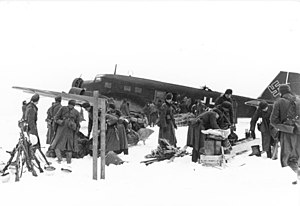Demyansk Pocket
| Demyansk Pocket | |||||||
|---|---|---|---|---|---|---|---|
| Part of the Eastern Front of World War II | |||||||
 |
|||||||
|
|||||||
| Belligerents | |||||||
|
|
|
||||||
| Commanders and leaders | |||||||
|
Walter von Brockdorff-Ahlefeldt Walther von Seydlitz-Kurzbach |
Pavel Kurochkin | ||||||
| Strength | |||||||
| 100,000 (initial) 31,000 replacement troops |
400,000 (initial) | ||||||
| Casualties and losses | |||||||
|
16th Army (10.01. - 31.05.1942): 11,777 KIA and 2,739 MIA 40,000 WIA Total: 55,000 |
Northwestern Front (07.01. - 20.05.1942): 88,908 KIA and MIA 156,603 WIA Total: 245,500 |
||||||
The Demyansk Pocket (German: Festung Demjansk or Kessel von Demjansk; Russian: Демя́нский котёл) was the name given to the pocket of German troops encircled by the Red Army around Demyansk (Demjansk), south of Leningrad, during World War II on the Eastern Front. The pocket existed mainly from 8 February to 21 April 1942. A much smaller force was surrounded in the Kholm Pocket at the town of Kholm, about 100 km (62 mi) to the southwest. Both resulted from the German retreat following their defeat during the Battle of Moscow.
The successful defence of Demyansk, achieved through the use of an airbridge, was a significant development in modern warfare. Its success was a major contributor to the decision by the Wehrmacht command to try the same tactic during the Battle of Stalingrad.
The encirclement began as the Demyansk Offensive Operation, the first phase being carried out from 7 January-20 May 1942 on the initiative of General Lieutenant Pavel Kurochkin, commander of Northwestern Front. The intention was to sever the link between the German Demyansk positions, and the Staraya Russa railway that formed the lines of communication of the German 16th Army. However, owing to the very difficult wooded and swampy terrain, and heavy snow cover, the initial advance by the Front was very modest against stubborn opposition.
On 8 January, a new offensive called the Rzhev–Vyazma Strategic Offensive Operation started. This incorporated the previous Front's planning into the Toropets–Kholm Offensive Operation between 9 January and 6 February 1942 which formed the southern pincer of the attack that, beginning the second phase of the northern pincer Demyansk Offensive Operation between 7 January and 20 May, which encircled the German 16th Army's (Generaloberst Ernst Busch) II Army Corps, and parts of the X Army Corps (General der Artillerie Christian Hansen) during winter 1941/1942.
...
Wikipedia
